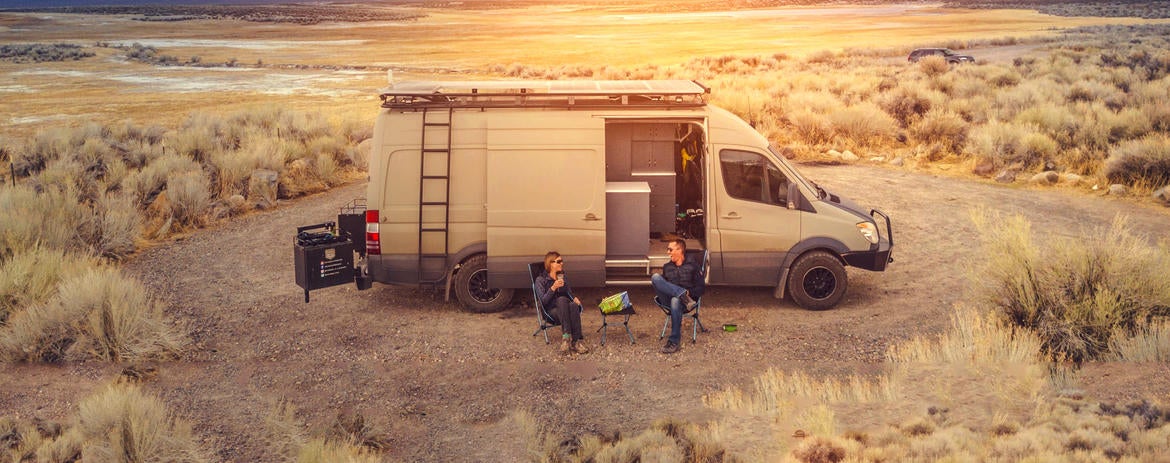Van Life
- Get link
- X
- Other Apps

#VanLife
Meet the Couple Who Live, Work and Travel in This Tricked-Out Van
Share
96
SHARES
Stephanie and Nate Yarbrough, both 29, may live in a van, but it’s not what you think. Theirs is a tricked-out 2007 Dodge Sprinter, complete with custom cabinets, a full-size bed and 825 watts of solar panels on the roof.
Ever wondered what life on the road is really like? We caught up with Stephanie to talk about the highs, lows and financial realities of #vanlife.
What inspired you to pack up your life in Denver and travel full time?
Nate and I always wanted to travel. We'd thought we’d do that in retirement, but about two and a half years ago, my father-in-law passed away at 53. It hit us hard. He had been retired for about three years, and spent the whole time fighting cancer.
We thought, ‘Wow, you're not guaranteed even tomorrow.’ We decided to go ahead and start enjoying our lives now, rather than working so hard for what we may not be able to enjoy later.
Why did you choose van life over staying in hostels or other types of cheap travel?
We wanted our dogs to be comfortable. It's also nice to have a familiar space to call home when you're traveling full time. [Plus], with our van, we own something, so it feels a bit more sustainable than just shelling out money all the time and not having an asset to show for it.
How do you earn a living on the road?
Nate is a self-employed videographer. I’d done business consulting remotely before, so I decided to start my company again [a short time after we started traveling]. If I could do it from home in Denver, I can do it from my van. I haven't fully replaced my previous salary yet, but I am living comfortably and able to save money. And I work less than I did at my former job, so I'd count that as a win!
How much did it cost to outfit your van, and what did you do to get ready?
The total cost was just under $40,000. That includes the $12,400 initial price of the van. Nate and I did everything ourselves over three months. I’d guess we saved around $50,000 by not hiring a builder and deciding ourselves where to go higher quality and where we could afford a less costly alternative.
For example, a builder would have told us that our options to change the outside color of the van would be to paint it or vinyl-wrap it, [which cost] $7,000 to $10,000. We decided to take a chance and PlastiDip [a specialty rubber coating] the van, which cost less than $800.
How do you fit everything you own in such a small space?
We just don't have a lot of stuff. And everything has a dual purpose. For example, we added swivel driver and passenger seats, so that we can turn them around to create a living area. This allowed us to forgo dedicated seating in the living area.
[Preparing for van life] makes you really think about why you need things—or if you actually do. We sold our two cars, [as well as] some of our larger items before we left, and gave most of our furniture away to a coworker.
What are your regular expenses now, and how does that compare to life before?
It’s much cheaper living in the van. In Denver, our housing, HOA fees and utilities totaled about $1,300 per month. Now, our basic spending averages $400 per month. We stay on free, [public] land often, and rarely pay for campgrounds—so some months, this number can be nearly zero. We get free electricity from the solar blocks, and we can often find water at rest stops. For Internet, we have an unlimited data plan on our cell phones, and tether that to our laptops. We don’t have a loan on the van.
We actually spend about the same amount in fuel now as we did having two cars in Denver. Our monthly food budget, which includes eating out, breweries, groceries and dog food, is about $600. When we lived in Denver, that number was easily over $1,000 per month [because] we were so close to so many good restaurants and went out to eat excessively.
Get the Grow Newsletter
The best money advice you never got, delivered to your inbox biweekly.
How has living in a van affected your ability to save?
We definitely can put more money into our savings account now because our everyday expenses are lower and we don’t spend on things that aren’t useful.
Before we set off on this adventure, we had a pretty decent padding in our savings account, and we don't touch that. We do [also] save for retirement. I want to make sure that we have enough money, so that in the future we are able to work less or disconnect more—or whatever retirement may look like then. Living in the van now helped us realize what we had planned before—buying an RV and traveling around in retirement—[may not be the lifestyle we want] at 70 years old.
What are your favorite things about living in and working on the road?
I make my own schedule. I don't have to be in a particular area at any particular time. A couple weeks ago, we were in Mammoth Lakes, Calif. I had a break in my day, and I was a little stressed. So my husband and I went out and sat in a natural hot spring, right outside of our door. I relaxed, got refocused, then came back in and hopped on a call with a client.
What tips do you have for other people who are considering a mobile lifestyle?
It’s not always rainbows and sprinkles. Just this past winter, our van broke down in Bozeman, Mont., in a Home Depot parking lot when it was -6 degrees. I think a lot of people see our lifestyle, and think, ‘Wow, that must be so fantastic. You just get to play all the time.’ It is fantastic, but you’ve got to be realistic about [the planning and upkeep involved].
What are your plans for the next several years?
This is indefinite. I don't know how long we'll be in the van, but we'll be traveling for as long as I can foresee. We may end up going overseas at some point, maybe backpacking for a while.
This interview has been edited for brevity and clarity.
June 26, 2018
- Get link
- X
- Other Apps





Comments
Post a Comment